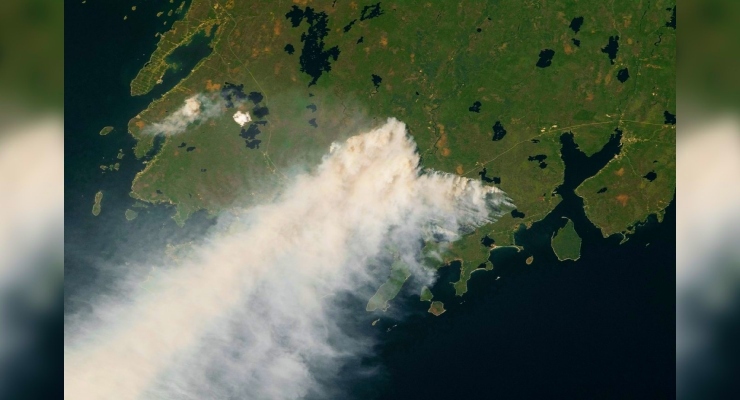
An astronaut aboard the International Space Station photographed wildfire smoke from Nova Scotia billowing over the Atlantic Ocean in May 2023. Warm weather and lack of rain fueled blazes across Canada last year, burning 5% of the country’s forests. Credit: NASA
Jet Propulsion Laboratory has led a groundbreaking study quantifying the massive carbon emissions from Canada’s devastating 2023 wildfires.
The research, published Monday in Nature, reveals that the fires released approximately 640 million metric tons of carbon between May and September 2023, surpassing the annual fossil fuel emissions of Russia or Japan in 2022.
“What we found was that the fire emissions were bigger than anything in the record for Canada,” said Brendan Byrne, a Jet Propulsion Laboratory scientist and lead author of the study.
Using satellite observations and advanced computing techniques, the JPL-led team calculated that the fires burned an area roughly the size of North Dakota, accounting for 5% of Canadian forests.
Researchers used data from the European Space Agency’s TROPOspheric Monitoring Instrument aboard the Sentinel 5P satellite to measure carbon monoxide in the atmosphere. They then used this to estimate carbon dioxide emissions based on ratios between the two gases in fire plumes.
The study attributes the intense fire season to exceptionally warm and dry conditions. Northwestern Canada, where 61% of fire emissions occurred, experienced temperatures more than 4.5 degrees Fahrenheit above average and precipitation over 3 inches below average during the fire season.
Byrne warned of potential future implications, stating, “Some climate models project that the temperatures we experienced last year will become the norm by the 2050s. The warming, coupled with lack of moisture, is likely to trigger fire activity in the future.”
The study, funded by NASA as part of its mission to understand Earth’s changing climate, raises questions about the long-term impact on Canada’s forests, which typically act as a significant carbon sink.
JPL scientists note that while both wildfires and fossil fuel combustion release carbon dioxide causing immediate warming, forests can eventually reabsorb wildfire emissions as they regrow, unlike fossil fuel emissions.
The research team’s findings underscore the need for continued monitoring and study of extreme wildfire events and their effects on global climate patterns.














 4 comments
4 comments



